Originally posted on December 5, 2023 @ 9:05 pm
Welcome to your ultimate guide on brisket! Have you ever wondered what brisket is called in the grocery store? Well, you’re in the right place. Brisket is a delicious cut of beef that comes from the chest of the animal, and it can go by different names depending on where you shop.
Brisket consists of two muscles called the “point” and the “flat.” The point is known for its marbling and is often referred to as “fatty brisket,” while the flat is leaner and called “lean brisket.” When you’re browsing the meat section of your local grocery store, you may come across different labels for brisket.
So, what is brisket called in the grocery store? It can be labeled as small brisket pieces with trimmed fat, whole-packer brisket, or flat cut brisket. You may also find pre-marinated and smoked brisket options for added convenience and flavor.
Now that you know what brisket is called in the grocery store, let’s dive deeper into the anatomy of this versatile cut of meat.
Table of Contents
Key Takeaways:
- Brisket in the grocery store can be labeled as small brisket pieces with trimmed fat, whole-packer brisket, or flat cut brisket.
- Pre-marinated and smoked brisket options are also available.
- Brisket consists of the “point” and the “flat” muscles.
- The point is marbled with fat and referred to as “fatty brisket,” while the flat is leaner and called “lean brisket.”
- Brisket is a versatile cut of meat that can be used in a variety of dishes.
Understanding the Anatomy of Brisket
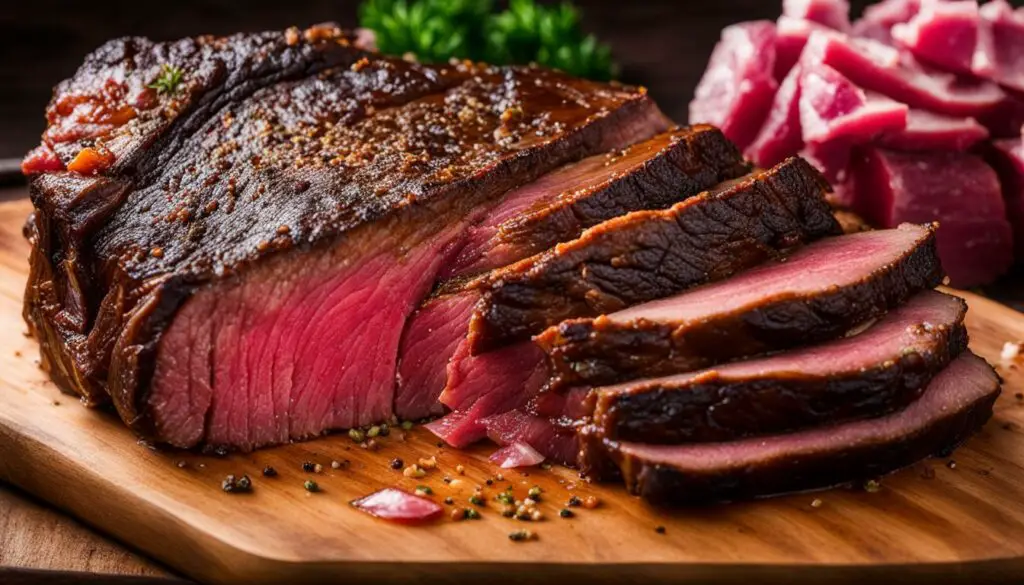
Beef brisket is a complex and versatile cut of meat that comes from the chest muscles of the cow. It is a tough cut with a lot of connective tissue, which requires low and slow cooking methods to become tender and flavorful. Understanding the different parts of the brisket can help you cook it to perfection.
There are three main portions of the brisket: the point, the flat, and the fat cap. The point is the thicker, marbled end of the brisket, known for its richness and succulence. The flat is a leaner portion, with less marbling and a firmer texture. The fat cap is a layer of fat that sits on top of the flat, providing moisture and flavor during the cooking process.
When preparing brisket, it is important to decide which portion you want to cook. A whole brisket, also known as a packer brisket, includes both the point and the flat, while a flat cut brisket only consists of the leaner flat portion. The cooking time and flavor profile can vary depending on the portion you choose.
| Brisket Portion | Description |
|---|---|
| Point | Thicker, marbled end of the brisket; rich and succulent |
| Flat | Leaner portion with less marbling; firmer texture |
| Fat Cap | Layer of fat on top of the flat; provides moisture and flavor |
By understanding the anatomy of brisket, you can choose the right portion for your preferred cooking method and flavor preferences. Whether you’re smoking, roasting, or slow-cooking, knowing the different parts of the brisket will enhance your culinary experience and help you create mouthwatering dishes.
Different Names for Brisket in the Grocery Store
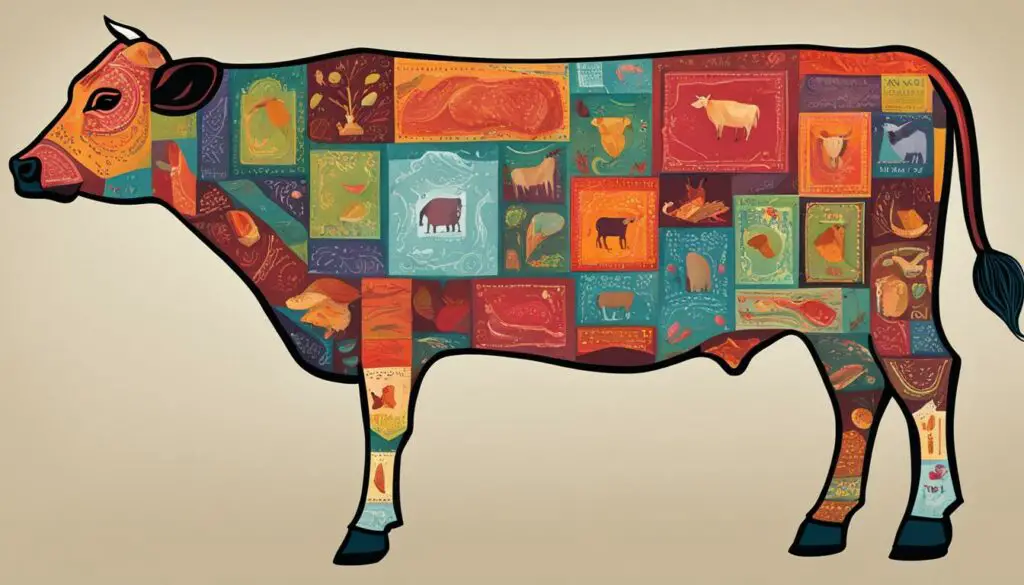
When it comes to purchasing brisket at the grocery store, you may come across different names that refer to various parts of the cut. Understanding these alternative names can help you choose the right type of brisket for your cooking needs. Here are some common names you might encounter:
- Flat Cut: This refers to the leaner portion of the brisket, which is ideal for dishes that require less fat.
- Deckle: Also known as the point cut, this refers to the triangular-shaped end of the brisket that is fattier and more flavorful.
- Point Cut: Similar to deckle, this term is used to describe the marbled, fatty part of the brisket.
- Fat Cap: This refers to the layer of fat on the surface of the brisket, which can add flavor and moisture during cooking.
Each cut has its own unique characteristics that can impact the texture and flavor of the final dish. Whether you prefer a leaner flat cut or a more marbled point cut, understanding these names will help you make an informed decision when purchasing brisket at the grocery store.
Table: Different Names for Brisket in the Grocery Store
Here is a table summarizing the different names for brisket in the grocery store:
| Name | Description |
|---|---|
| Flat Cut | Leaner portion of the brisket |
| Deckle | Triangular-shaped, fattier end of the brisket |
| Point Cut | Marbled, fatty part of the brisket |
| Fat Cap | Layer of fat on the surface of the brisket |
Did You Know?
Brisket is known by different names in various cuisines around the world. In German cuisine, it is called “braten,” while in French cuisine, it is known as “palette de boeuf.” Italians refer to it as “petto di manzo,” and in Brazilian cuisine, it is called “maminha.”
Next time you’re at the grocery store and looking for brisket, keep these alternative names in mind. They will help you navigate the various cuts and choose the perfect piece for your next delicious meal.
What Does Brisket Look Like in the Grocery Store?
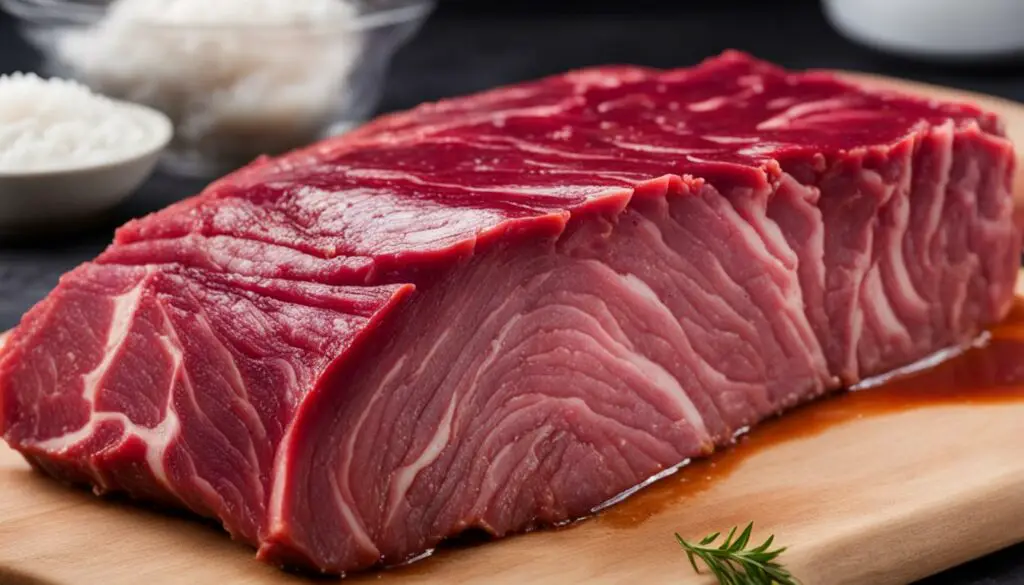
In the grocery store, brisket is typically sold as a large, flat cut of beef with a thick layer of fat on one side. It may come wrapped in cellophane or pre-packaged. Some grocery stores also offer pre-marinated or smoked brisket, which is ready to cook and has a smoky flavor.
Brisket packaging may vary depending on the store and brand. However, it is commonly found in a sealed plastic wrap to preserve freshness. This packaging helps to keep the brisket moist and prevents any leakage. Be sure to check the label for any specific cooking instructions or additional ingredients if purchasing pre-marinated or smoked brisket.
When selecting brisket in the grocery store, it is important to look for a cut that has a deep red color. This indicates freshness and flavor. The layer of fat on one side of the brisket should be white and well-distributed, as this fat helps to keep the meat moist during the cooking process. Avoid briskets that have a grayish color or an excessive amount of fat, as these may not result in the best-tasting final dish.
Table: Brisket Packaging Options
| Packaging Type | Description |
|---|---|
| Sealed Plastic Wrap | The most common packaging option for brisket. It helps to preserve freshness and prevent leakage. |
| Pre-Packaged | Some grocery stores offer pre-packaged brisket, which may come with additional ingredients or marinades. |
| Pre-Marinated | Pre-marinated brisket is already seasoned or marinated, saving time and effort in the preparation process. |
| Smoked | Smoked brisket is cooked using the smoking method, resulting in a distinct smoky flavor. |
Where to Buy Brisket
Brisket is a popular cut of beef that can be found in various places, including grocery stores, local butcher shops, and warehouse clubs like Costco and Sam’s Club. If you’re looking to buy brisket, here are some options to consider:
1. Grocery Stores
Most large grocery stores have a meat department where you can find brisket. Look for it in the beef section, either as whole-packer brisket or flat cut brisket. Some grocery stores may also offer pre-marinated or smoked brisket for convenience.
2. Local Butcher
For a more personalized and specialized experience, consider visiting your local butcher. They can provide you with expert advice on choosing the right cut and grade of beef for your brisket. They may also be able to custom trim or prepare the brisket according to your preferences.
3. Warehouse Clubs
If you’re looking to buy brisket in bulk or for a larger gathering, consider visiting warehouse clubs like Costco or Sam’s Club. These stores often offer whole briskets at competitive prices, making it a cost-effective option for larger quantities.
When purchasing brisket, it’s important to choose the right grade of beef for the best flavor. USDA Choice or Prime beef is recommended for its tenderness and marbling. Additionally, inspect the brisket for a deep red color and look for packaging that is free from damage or excessive liquid.
| Where to Buy Brisket | Pros | Cons |
|---|---|---|
| Grocery Stores | Convenient, wide availability | May have limited selection or quality |
| Local Butcher | Personalized service, expert advice | May have higher prices or limited hours |
| Warehouse Clubs | Cost-effective for bulk purchases | Requires membership, larger quantities |
Whether you choose to buy brisket at a grocery store, local butcher, or warehouse club, it’s important to select the right cut and quality to ensure a delicious and satisfying meal. Explore your options, ask for recommendations, and enjoy the process of finding the perfect brisket for your next cooking adventure.
Brisket: A Versatile Cut of Meat
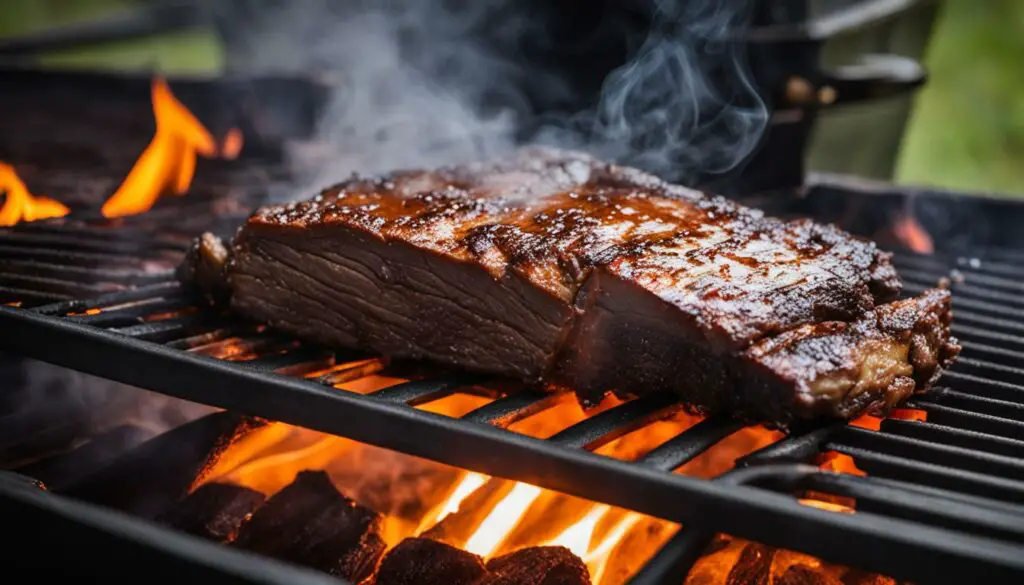
Brisket is not only a flavorful cut of beef, but it is also incredibly versatile in the kitchen. Its rich taste and tender texture make it a popular choice for a variety of dishes. Whether you’re looking to create succulent pulled beef sandwiches, mouthwatering tacos, hearty stews, or comforting soups, brisket is the perfect ingredient to elevate your meals.
One of the most popular uses for brisket is in pulled beef sandwiches. Slow-cooked until tender, the meat easily shreds apart and becomes a delicious filling for sandwiches. Add your favorite BBQ sauce and some coleslaw for a classic and satisfying meal.
Brisket is also a fantastic choice for tacos. Seasoned with spices and slow-cooked, the meat develops a deep and complex flavor that pairs well with fresh toppings such as salsa, avocado, and cilantro. Whether you prefer soft tortillas or crispy shells, brisket tacos are sure to be a crowd-pleaser.
In addition to sandwiches and tacos, brisket is a staple in many hearty stews and soups. The long cooking time allows the flavors to meld together, resulting in a comforting and satisfying dish. Whether you’re making a classic beef stew, a rich chili, or a comforting vegetable soup, adding brisket will take your creation to the next level.
With its versatility and delicious taste, brisket is a cut of meat that should not be overlooked in the kitchen. From sandwiches to tacos, stews to soups, the possibilities are endless. Experiment with different seasonings and cooking methods to discover your favorite way to enjoy this flavorful beef.
Tips for Buying Brisket at the Grocery Store
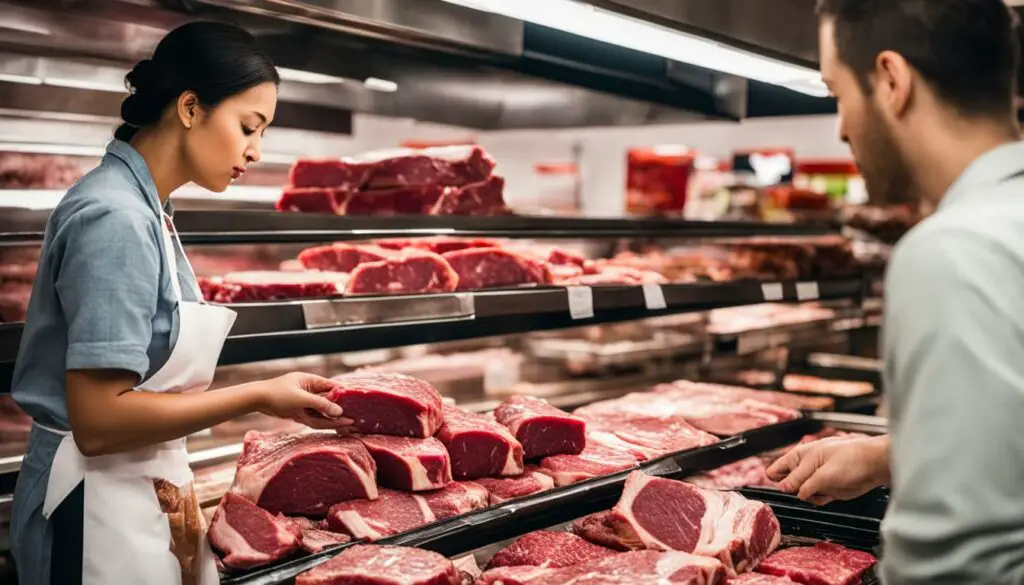
When it comes to buying brisket at the grocery store, there are a few key factors to consider to ensure you get the best cut of meat for your needs. Here are some tips to help you choose the perfect brisket:
Inspecting Marbling:
One of the most important things to look for when buying brisket is marbling. Marbling refers to the small streaks of fat that are dispersed throughout the meat. These fat deposits enhance the flavor and tenderness of the brisket. Look for a brisket with ample marbling for maximum flavor and juiciness.
Fat Layer:
Another important aspect to consider is the fat layer on the brisket. The fat layer plays a crucial role in keeping the meat moist during the cooking process. Look for a brisket with a thick, even layer of fat on one side. The fat should be white or slightly yellow in color.
Deep Red Color:
The color of the brisket can also give you an indication of its freshness and flavor. Look for a brisket with a deep red color. Avoid any cuts of meat that appear brown or have a grayish tint, as this may indicate spoilage.
USDA Choice or Prime Beef:
For the best quality and flavor, consider choosing brisket that is labeled as USDA Choice or Prime beef. These grades indicate that the meat has met certain standards of marbling and tenderness. While these cuts may be slightly more expensive, they are worth it for the superior flavor and texture they provide.
| Label | Description |
|---|---|
| Marbling | Look for ample marbling throughout the meat for maximum flavor and tenderness. |
| Fat Layer | Choose a brisket with a thick, even layer of fat on one side to keep the meat moist during cooking. |
| Color | Opt for brisket with a deep red color, indicating freshness and flavor. |
| USDA Choice or Prime | Consider selecting brisket labeled as USDA Choice or Prime for superior quality and tenderness. |
By following these tips, you can confidently choose the perfect brisket at the grocery store for a delicious and satisfying meal.
Brisket: A Cut with Many Names Around the World
Brisket, a beloved cut of beef, is known by different names in various countries, highlighting its global popularity and versatility. Let’s take a culinary journey and explore the diverse names that this delicious cut is called.
Germany: Braten
In Germany, brisket is referred to as “braten.” It is a staple in German cuisine and is often slow-cooked to achieve a tender and flavorful result. Traditional German recipes utilize the rich flavors of brisket, showcasing the country’s love for hearty and comforting dishes.
France: Palette de Boeuf
When in France, you may come across brisket being referred to as “palette de boeuf.” This name translates to “beef shoulder” in English, which reflects the location of the cut on the animal. In French cuisine, brisket is commonly used in dishes like pot-au-feu, a classic beef stew.
Italy: Petto di Manzo
Italian cuisine celebrates brisket as “petto di manzo.” Italians are renowned for their passion for food, and brisket is no exception. This cut is often prepared in slow-cooked dishes like brasato, a hearty beef stew that showcases the tenderness and flavor of the meat.
Brazil: Maminha
Brisket is known as “maminha” in Brazil, where it is immensely popular. This flavorful cut is commonly enjoyed in Brazilian barbecue, known as churrasco. The smoky and succulent maminha is a favorite among meat lovers, offering a melt-in-your-mouth experience.
Mexico: Falda de Res
In Mexico, brisket goes by the name “falda de res,” which translates to “beef skirt.” It is a versatile cut that is used in various Mexican dishes, including tacos, stews, and barbacoa. The richness and tenderness of falda de res add depth and flavor to these traditional Mexican delicacies.
Argentina: Tapa de Asado
Argentinians know brisket as “tapa de asado,” a popular cut in their renowned asados (barbecues). The tender and juicy meat is often grilled to perfection, highlighting Argentina’s grilling culture and love for flavorful meats.
These are just a few examples of how brisket is referred to in different parts of the world. Regardless of its name, this versatile and delicious cut of beef has captured the hearts and palates of people from diverse culinary backgrounds.
The History and Significance of Brisket
Brisket carries a rich history, particularly within Ashkenazi Jewish communities, where it holds great significance as a traditional holiday dish. For centuries, this flavorful cut of beef has been cherished and enjoyed during festive occasions such as Rosh Hashanah, Passover, and Hanukkah. The preparation and consumption of brisket during these celebrations have become deeply rooted in cultural traditions, making it a beloved centerpiece of the holiday table.
The roots of brisket’s popularity in the United States can be traced back to the early 20th century when European Jewish immigrants settled in Texas. These immigrants brought with them their cherished recipes and cooking techniques, including their love for slow-cooked, tender brisket. Over time, the flavors and traditions of Ashkenazi Jewish cuisine blended with the Texan love for barbecue, giving rise to the unique and mouthwatering Texas-style brisket that we know today.
Brisket’s role as a traditional holiday dish extends beyond the Ashkenazi Jewish community. Its versatility and ability to feed a crowd have made it a favorite choice for festive gatherings and celebrations across cultures and regions. Whether it’s served with latkes and applesauce during Hanukkah or alongside cornbread and coleslaw at a Fourth of July barbecue, brisket continues to be a symbol of joy, togetherness, and culinary tradition.
| Key Takeaways |
|---|
| Brisket is an integral part of Ashkenazi Jewish holiday traditions, enjoyed during festive occasions such as Rosh Hashanah, Passover, and Hanukkah. |
| The popularity of brisket in the United States grew with the immigration of European Jewish people to Texas in the early 20th century, blending their cooking traditions with Texan barbecue. |
| Brisket’s versatility and ability to feed a crowd have made it a beloved choice for festive gatherings and celebrations across cultures and regions. |
Brisket is more than just a cut of beef; it represents the coming together of family, tradition, and celebration. The slow cooking process and the melt-in-your-mouth tenderness of the meat creates a sense of anticipation and warmth around the table. From generation to generation, the love for brisket has been passed down, ensuring that this humble cut of beef continues to hold a special place in our hearts and on our plates.
Conclusion
Brisket is a versatile cut of beef that can be found in grocery stores under various names. Whether it’s labeled as flat cut, point cut, or deckle, each part of the brisket brings its own unique characteristics to the table. When choosing brisket, it’s important to select the right cut and grade of beef for the best flavor.
Brisket is a true culinary chameleon, lending itself to a wide range of dishes. From mouthwatering pulled beef sandwiches to hearty stews and soups, it can elevate any meal. The key to tender and juicy brisket lies in slow cooking at low heat, allowing the flavors to develop and the meat to become melt-in-your-mouth delicious.
Whether you prefer grilling, smoking, roasting, or slow-cooking, brisket is sure to satisfy your taste buds. Experiment with different seasoning blends and cooking techniques to create a personalized culinary masterpiece. So, the next time you visit the grocery store, don’t forget to consider the many possibilities that await you with this versatile and flavorful cut of beef.
FAQ
What is brisket called in the grocery store?
Brisket can be labeled as small brisket pieces with trimmed fat, whole-packer brisket, flat cut brisket, or deckle in the grocery store.
What is the anatomy of brisket?
Brisket is a cut of beef from the chest of the animal, consisting of two muscles called the “point” and the “flat.” The point is often marbled with fat and referred to as “fatty brisket,” while the flat is leaner and called “lean brisket.”
What are the different names for brisket in the grocery store?
Brisket can be labeled as flat cut, deckle, point cut, or fat cap in the grocery store, referring to different parts of the brisket with varying characteristics.
What does brisket look like in the grocery store?
Brisket is typically sold as a large, flat cut of beef with a thick layer of fat on one side. It can come wrapped in cellophane or pre-packaged. Pre-marinated and smoked brisket options are also available.
Where can I buy brisket?
Brisket can be purchased at most large grocery stores or butcher counters. For a full-packer brisket, it is recommended to seek out a local butcher. Warehouse stores like Costco and Sam’s Club also offer whole briskets.
What can I make with brisket?
Brisket can be used in a variety of dishes, including pulled beef sandwiches, tacos, stews, and soups. It can be grilled, smoked, roasted, or slow-cooked to create a delicious and juicy meal.
How do I choose brisket at the grocery store?
When buying brisket, look for a cut with marbling, fat mixed in, for maximum flavor. Choose brisket with a deep red color, indicating freshness and flavor. USDA Choice or Prime beef is recommended for the best quality. Inspect the packaging for any signs of damage or excess liquid.
What are the different names for brisket around the world?
Brisket is known as “braten” in Germany, “palette de boeuf” in France, “petto di manzo” in Italy, “maminha” in Brazil, “falda de res” in Mexico, and “tapa de asado” in Argentina.
What is the history and significance of brisket?
Brisket has historical significance, particularly in Ashkenazi Jewish communities. It has been a traditional holiday dish, commonly eaten on holidays such as Rosh Hashanah, Passover, and Hanukkah. The popularity of brisket in the United States grew with the immigration of European Jewish people to Texas in the early 20th century.
Source Links
- https://www.realsimple.com/food-recipes/cooking-tips-techniques/what-is-brisket
- https://eatpallet.com/what-is-beef-brisket-called-in-the-grocery-store/
- https://heygrillhey.com/brisket-101/
See also:
Leave a Reply